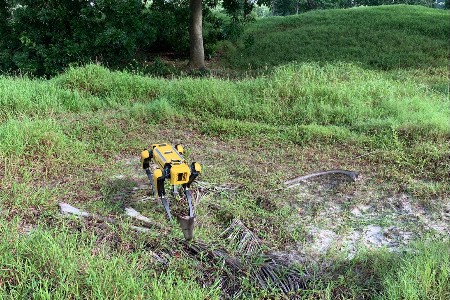May 11, 2020 – A city park in Singapore is implementing safe distancing practices as the country slowly relaxes its COVID-19 emergency restrictions.
How is it doing it?
A robot dog named Spot (how entirely unoriginal if your as old as I am and had to read “Fun with Dick and Jane” as a child) built by Boston Dynamics, began patroling Bishan-Ang Mo Kio Park last Friday. This is an initial two-week trial in which the four-legged bot wanders through the park and along its many sidewalks to remind park visitors to practice social distancing.
Spot comes with an onboard 360-degree camera and data analytics software that determines the number of people in the park at any time. The initial test is over a three-kilometer stretch during off-peak hours. Spot is accompanied by a human attendant. If the trial is successful, Spot will be deployed regularly during morning and evening peak hours. And other spots will become a part of many of the other parks in the city-state.
Boston Dynamics has been working on advanced mobile robots for a number of years. The company’s early years involved work on robot development for DARPA, the U.S. Defence Advanced Research Agency. For a period of time, Google was a major investor in the company located in Waltham, Massachusetts. More recently the operation was acquired by SoftBank, a Japanese multinational.
Spot is a quadruped robot that can be used both in and outdoors. It walks at a good pace and can manage going up and downstairs as well as all kinds of uneven terrain and obstacles (see picture below). It has wrap-around vision and obstacle detection and avoidance capability. It can operate autonomously and has situational awareness. It also can be operated remotely by a human if needed.

When Boston Dynamics designed the robot it saw it as useful for work in areas that could be deemed dangerous to humans. For example, it could be deployed to inspect hazardous areas at an industrial plant: think nuclear power plants and electrical utility sites. With a human operator, it could be deployed to deal with checking out a suspicious package. Or in a hospital or emergency medical situation could use it in quarantined areas, or have it deliver food and medicine without putting caregivers in harm’s way.
In Singapore, the use of Spot in park patrols means the city-state can stretch out staffing requirements for preventing new COVID-19 hotspots from emerging by enforcing social distancing. And this isn’t the only place where Spot is being deployed in Singapore. A brother to the park robot is being trialed at the Changi Exhibition Centre, a community quarantine facility in the city that his housing people with mild COVID-19 symptoms. That robodog provides a delivery service to the patients including bringing them their medications.
Singapore is figuring out even more tasks for Spot in the future. Meanwhile, it is testing other deployable robots including 30 drones to monitor its parks. Before Spot, the city-state launched a four-wheeled autonomous robot named PUB which was also deployed to one of the parks. But being on wheels doesn’t allow the robot to go off paved paths. Spot can do that.
Singapore seems to have always loved robots. It has the second-highest robot-to-human-worker density in the world, only surpassed by South Korea. Besides the parks, you find robots roaming in food courts, robot greeters in retail stores, and robots providing room service delivery to hotel guests. Robots in the hospital dispense medication. The city’s airport deploys robot cleaners. And there are even robot short-order cooks. More recently an autonomous electric-powered bus was launched with capacity for 80 passengers following a prescribed route. So Spot should fit in quite nicely in the city-state blending in with an increasingly 21stcenturyish environment that embraces new technology like no other.








